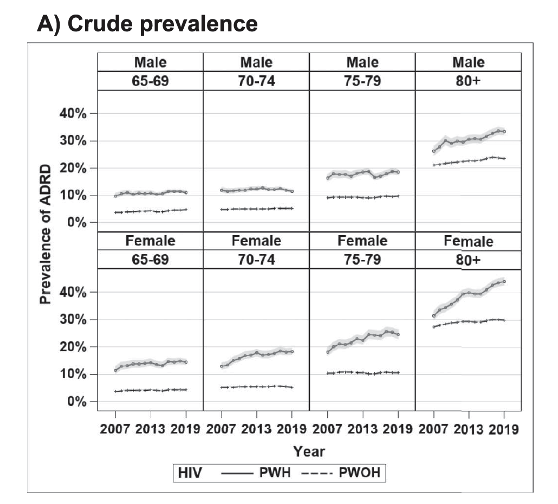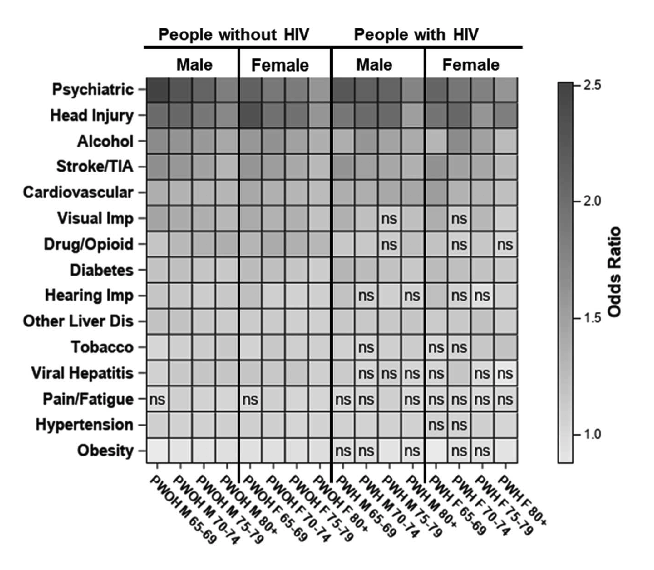| |
PWH had a higher prevalence of AD (alzheimers)/ADRD.
PWH had a higher burden of dementia
|
| |
| |
Download the PDF here
PWH had a higher prevalence of AD (alzheimers)/ADRD, which increased over time compared with PWOH, especially among female beneficiaries. PWH had a higher burden of dementia
Results:
PWH had a higher prevalence of AD/ADRD, which increased over time compared with PWOH, especially among female beneficiaries and with increasing age.
For example, among those aged 80+ years, the prevalence increased from 2007 to 2019
- (females with HIV: 31.4%-44.1%; females without HIV: 27.4%-29.9%;
- males with HIV: 26.2%-33.3%; males without HIV: 21.0%-23.5%).
After adjustment for demographics and comorbidities, the differences in dementia burden by HIV status remained, especially among older age groups.
Conclusions:
Older Medicare enrollees with HIV had an increased dementia burden over time compared with those without HIV, especially women and older subjects. This underscores the need to develop tailored clinical practice guidelines that facilitate the integration of dementia and comorbidity screening, evaluation, and management into the routine primary care of aging PWH.
Dementias Among Older Males and Females in the U.S. Medicare System With and Without HIV
u, Xiaoying MD, PhDa,b; Kuo, Yong-Fang PhDa,b; Raji, Mukaila A. MDc; Berenson, Abbey B. MD, PhDb,d; Baillargeon, Jacques PhDe; Giordano, Thomas P. MD, MPHf,g
JAIDS June 1 2023
In conclusion, older Medicare enrollees with HIV had an increased dementia burden over time compared with those without HIV, especially women and older subjects. Age-related comorbidities-especially psychiatric disorders, which are more prominent in women-were strongly associated with this trend. These findings underscore the need to develop clinical practice guidelines that facilitate the integration of dementia and comorbidity screening, evaluation, and management into the routine primary care of aging PWH.
This study found that PWH had a higher prevalence of AD/ADRD, which increased over time compared with PWOH, especially among female beneficiaries. The differences between PWH and PWOH largely decreased after adjustment for demographics and comorbidities. However, differences in dementia burden remained, especially among older age groups. We also found a spectrum of comorbidities associated with AD/ADRD, with psychiatric disorders the most prominent among these. Within each age stratum, we found that PWH had a higher burden of dementia, which increased faster compared to PWOH, in men and women. The oldest groups were most affected, especially among women.
Women with HIV had a higher adjusted prevalence of AD/ADRD in all age categories and the increasing trend was more pronounced in those age 75+, reflecting differential trends between women with and without HIV, statistically shown as significant HIV-year interactions (P = 0.01 and 0.002 respectively in Fig. 2D).
the top 5 conditions associated with AD/ADRD were psychiatric disorders, head injury, stroke/transient ischemic attack, alcohol abuse disorder, and cardiovascular diseases in PWH and PWOH. Particularly, for psychiatric disorders, the ORs (95% CI) ranged from 1.61 (1.55-1.67) to 2.26 (2.14-2.37) and 1.61 (1.60-1.62) to 2.52 (2.45-2.59) for PWH and PWOH respectively, with stronger associations in younger age groups and among women.
FIGURE 2.:
Prevalence of AD/ADRD. AD/ADRD, Alzheimer disease (AD)/AD-related dementias (ADRD).

These results are generalizable to the older FFS Medicare population and have important implications for the management and treatment of dementia among patients with HIV. Given the increasingly high burden of dementia among older Medicare enrollees with HIV, enhanced regular screening for dementia among PWH and comprehensive management of dementia are indicated. The significantly higher burden of dementia among women with HIV and older age subgroups highlights the necessity of closely monitoring treatment and supporting engagement in the care of these vulnerable patients. In addition, early treatment of comorbidities, especially psychiatric disorders, alcohol and drug use disorders, and cardiovascular diseases in PWH is critical, given the additional risk of dementia in this population. Implementing these strategies will not only extend the lifespan of PWH, but also improve their healthspan and quality of life.56
After accounting for demographics and comorbidities, PWH still had excess risks that differed among subgroups, which could be explained by unmeasured factors, such as HIV clinical factors (disease stage, treatment), education, and social support. CD4 nadir is a predictor of HIV neurocognitive impairment and initiation of ART as early as possible may reduce the risk of developing HIV-associated neurocognitive disorders.44 In contrast, it is possible that long-term exposure to certain ART drugs may cause chronic CNS toxicity.45-47 For example, a clinicopathologic study of PWH demonstrated that darunavir or ritonavir use was associated with higher likelihood of cerebral degenerative changes, such as neuronal phospho-tau lesions and marked microgliosis in the putamen.46 Human herpes viruses are another possible contributor to excessive risk in PWH.48,49 Further studies are needed to investigate these factors.
Given that older age is the main risk factor for dementia, the prolonged life expectancy among PWH will contribute to an increase in the prevalence of AD/ADRD in this population.
Our findings are generally consistent with the recent study that showed overall increases in dementia prevalence over time.22 The study found that the overall prevalence of dementia was higher among PWH in 2000-2016 [adjusted prevalence ratio 1.86, 95% CI: 1.70 to 2.04] and also in 2015-2016 (adjusted prevalence ratio 1.75, 95% CI: 1.56 to 1.97).22 Our study targeted an older population (≥65 years) and included Medicare beneficiaries from all U.S. states and DC. Thus, our analyses extend these findings to a much larger, more contemporary, older, national and rapidly growing population of PWH.
the top 5 conditions associated with AD/ADRD were psychiatric disorders, head injury, stroke/transient ischemic attack, alcohol abuse disorder, and cardiovascular diseases in PWH and PWOH. Particularly, for psychiatric disorders, the ORs (95% CI) ranged from 1.61 (1.55-1.67) to 2.26 (2.14-2.37) and 1.61 (1.60-1.62) to 2.52 (2.45-2.59) for PWH and PWOH respectively, with stronger associations in younger age groups and among women.

|
|
| |
| |
|
|
|